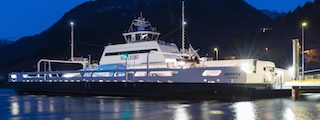The world’s first all-electric drive carry ferry began operating on a Norwegian fjord in January 2015, making 34 runs of 20 minutes each day, and recharging its batteries from the local power grid.
Powered by a pair of 450 kW motors and 10 tons of lithium batteries built by Siemens Norway, the lightweight all-aluminum ferry can carry up to 360 passengers and 120 vehicles across Sognefjord, the longest and deepest of Norway’s mountain-rimmed waterways. Siemens hopes the design can be used on as many as 50 ferry routes along the coast.
The first example of this 265’x68’ catamaran class, dubbed ZeroCat by builder Fjellstrand, is named Ampere, in honor of Andre-Marie Ampere, the French mathematician and physicist who founded electrodynamics. His name is how the amp, the unit of electrical power, gets its name.
The vessel is the outcome of a competition launched five years ago by Norway’s Ministry of Transport and Communications. The agency has jurisdiction over waterways and wanted a quieter and less polluting alternative to diesel ferries on the fjord, a major tourism destination.
Odd Moen, chief of ship solution sales for Siemens Norway, said the idea of an electric ferry had been around for a long time but was limited by available technology. That began to change in recent years, with better lithium ion batteries, and adapting the system to a relatively low-power rural power grid.
The onboard batteries store about 1,000 kilowatt-hours of power, enough for several passages on the nearly four-mile crossing between the villages Lavik and Oppedal. The problem with recharged directly from the grid was that the batteries’ sudden draw on the local grid “would cause the washing machines in all the houses in the area to stop running,” Moen said.
The solution is two 260 kilowatt-hour lithium batteries, one at each pier terminal, to buffer the grid. During each 10-minute layup after a crossing, the ferry recharges at a fast rate from the dockside battery to top off its own batteries. While the ferry is gone, the dockside batteries draw modest power slowly from the grid to charge themselves.
Late at night, when local power demand is lower, the ferry can recharge directly from the grid during its seven-hour down time. Siemens said that makes the ferry much more affordable than if it required expensive improvements to the local power supply. It’s close to a true zero-carbon emission vessel, because the grid is powered by hydroelectric technology, and a comparable diesel ferry would burn around 264,000 gals. of fuel in a year, according to Siemens.





